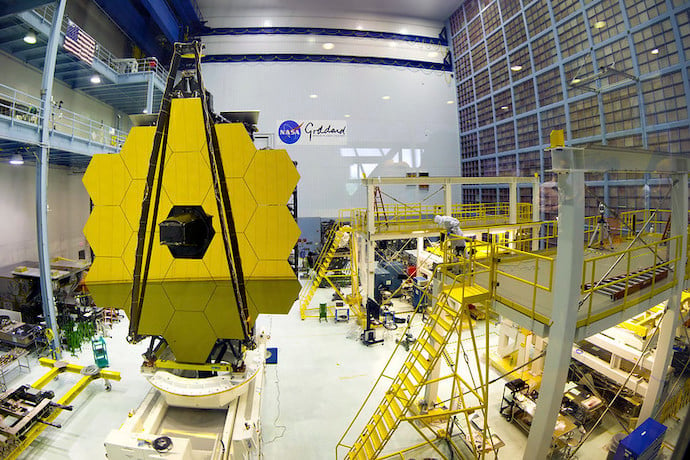On December 31, 2021 the James Webb Space Telescope (JWST) started unfurling its five layers of sunshield. The sunshield, about the size of a tennis court, is held out by booms and pulled tight. No one was completely sure the project would work.
“This is the first time we’ve done this deployment in zero gravity. Every other time we’ve done it in the clean room, we’ve had to take gravity into account,” Julie Van Campen said on NASA TV. Van Campen is deputy commissioning manager for JWST. There were serious questions about how the sunshield would react. In the end, it opened just as planned and there was cheering from the mission crew. One of the many critical steps was done.
On January 5, 2022 JWST accepted commands from Earth to move its secondary mirror into place.
“That was what I was most nervous about,” said Jonathan Gardner, deputy senior project scientist for JWST. “Without that mirror, the observatory would have collected light in the big mirror, but not been able to focus it.”
The mirror, like the sunshield, went into place without a hitch.
JWST launched on December 25, 2021, riding on an Ariane 5 rocket supplied by the European Space Agency. JWST is designed to look at ancient galaxies, and is the successor to the Hubble Space Telescope, which began gathering images of space in 1990.
For launch, the whole telescope was collapsed down. Getting it to pull its transformer act – changing from a bulky domino-shaped box into its almost flower-shaped finale – has been a nail-biting experience for the mission team and the audience alike. But almost everything went according to plan.
“It’s very exciting and kind of amazing,” Gardner said, having just watched the latches close on the big mirror, the last of the big pieces of equipment to snap into place on January 8. “We tested it before we launched to make sure it worked, and it did.”
Gardner has worked on JWST for almost 20 years and is one of 100 or so members of the mission team. The team worked around the clock for the first 30 days from their headquartered at the Space Telescope Institute in Baltimore, Maryland. The launch and deployment is a process they know well; they’ve been practicing for the last two years.
To do those practices, the JWST team used a giant computer program that simulated everything from launch to full deployment of the telescope. Everyone involved had to learn protocol of a launch. For instance, the order of deployment is organized by the timeline coordinators. And everyone listens to their MOM (Mission Operation Manager). MOM is the one says when engineers can send commands to the telescope.
And a lot of time is spent sitting around. “Some of the processes go very, very slowly,” Gardner said, explaining that heating up motors, for example, can take as much as 18 hours. “And we’re always looking for things that could go wrong.”
That’s where the RAT comes in. RAT stands for Rehearsal Anomaly Team. The job of these engineers is to meet secretly and come up with anomalies, or problems that might happen. The RATs then spring these anomalies on the team during rehearsals.
So during a rehearsal with the sunshield one of the motors didn’t turn on. The motor was designed for super-cold space, but sometimes motors object to being that cold.
This RAT-created problem “gave the team practice in how to respond when something goes wrong,” Gardner said. And the answer for the sunshield would be to switch to the secondary motor electronics.
The other part of the rehearsal is the coordination of the ground crew and their equipment. JWST commands are sent to one of three sites in the world: California, Spain or Australia, where 30-meter antennas can communicate with the deep-space telescope. As the Earth turns, a different antenna rotates into position to point in the right direction. The ground team had to practice the hand-off from one antenna to another.
The team also realized they needed to know what to do should the power go out in Baltimore. In an early rehearsal, the electricity did go out, Gardner said, and the emergency power came on. However, the air conditioning for the computer room wasn’t hooked into the emergency power, so computers overheated and that practice came to a stop. From then on, the air conditioning was put on the emergency power system as well.
During the real deployment, however, the team hasn’t needed too much of their RAT training, Gardner said. So far, the only anomaly has been in the solar array. “Our solar array was not putting out as much power as we needed,” he said. “So we went through the process to tune it.” The tuning, he explained, was supposed to get done on Day 30, but was moved up in the schedule so that the sunshield motors had power.
If everything stays on schedule, Gardner says JWST will be set up soon. “We should have first science images in early July,” he said.
And then, JWST will start peering through dust to look at stars and galaxies that haven’t even been imagined.
Learn More
Webb Telescope
https://www.nasa.gov/mission_pages/webb/main/index.html
Webb Sunsheild Deployment
https://www.youtube.com/watch?v=IBPNi7uGgWM
Webb Deployment Sequence
https://www.youtube.com/watch?v=RzGLKQ7_KZQ
Deep Space
https://eyes.nasa.gov/dsn/dsn.html
JWST Live Updates
https://www.space.com/news/live/james-webb-space-telescope-updates
James Web Telescope
https://www.youtube.com/watch?v=0BSaphO1v-U
Webb Space Telescope
The ultimate guide to JWST
https://www.space.com/21925-james-webb-space-telescope-jwst.html
JWST facts
https://kids.kiddle.co/James_Webb_Space_Telescope
Lesson plans, Activities and Resources
https://jwst.nasa.gov/content/forEducators/informal.html
Film about JWST
https://thekidshouldseethis.com/post/james-webb-space-telescope-hainline-smilemountain-film
Launch of the JWST
https://www.ariane.group/en/news_kid/find-out-about-the-launch-of-the-james-webb-space-telescope/
JWST investigations of origin of Universe
JWST Children’s Book/Author
https://www.unl.edu/physics/news/yu-creates-childrens-book-james-webb-space-telescope

